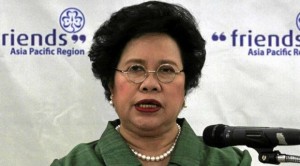Santiago: Next president should be female to meet PH gender equality goal
MANILA, Philippines – To ensure the United Nations Millennium Development Goals (UNMDG) of gender equality, Senator Miriam Defensor-Santiago on Tuesday batted for a female president in 2016.
“We’ve had 13 male and only two female presidents so far. The Philippines has had a total of 15 presidents. To achieve equality between males and females, since we have had 13 males, the next 11 presidents should be female,” Santiago said in a speech celebrating International Women’s Month at the International Rice Research Institute (IRRI) in Los Baños, Laguna.
“We should have a female president in 2016,” she said. “Research shows that when women are empowered as political leaders, countries often experience higher standards of living with positive developments in education, infrastructure and health care.”
To meet the standard of gender equality in the 2016 elections, Santiago said voters should also pick at least six female candidates in order to balance the male and female senators in the Senate.
Santiago said in numerical terms alone, there is still a wide gender gap in public office between the sexes.
Article continues after this advertisement“Numerically, half of our high government officials should be women, and half should be men. And yet the division between the sexes is highly disproportionate in favor of men. In the Philippine Senate, in the 16th Congress, of 24 senators, only six of us are women,” she pointed out.
Article continues after this advertisementWhile the country has had two female presidents and now a female chief justice, Santiago noted that Congress has never had a female Senate President, or a female Speaker.
“The greater majority in both chambers of Congress has always been men. Possibly, this is one reason why there is so much corruption in Congress,” she said.
The Civil Service Commission (CSC) has issued a memorandum circular setting a target of 50-50 representation of women and men in executive positions but in 2011, the senator said, the Commission found that women occupy only less than one-third of third-level positions in the government; more than one-third in government-owned and controlled corporations; less than 20 percent in local government units; and more than one-third in the judiciary.
Overall, the proportionate share is 1:2 in favor of men holding top posts in the government, Santiago said.
“Further, women government employees are more likely to be technical staff, while the men are likely to be clerks, managers, or executives,” she added.
The senator also expressed concern over the phenomenon of the “feminization of agriculture.”
In feminist economics, Santiago said, the feminization of agriculture refers to the measurable increase of women’s participation in the agricultural sector, particularly in the developing world.
“In Asia and sub-Saharan Africa, women contribute at least half of total labor inputs in rice production. In the Philippines, as of October 2010, there are 5 million women laborers and unskilled workers; and 839,000 women farmers, forestry workers, and fisherfolk,” she pointed out.
Santiago also noted that while women’s role in the agricultural sector continues to grow, women are often poorer than their male counterparts.
“Their plot sizes are smaller. They have less access to productive resources like education, tools, and seeds; and social connections like credit and market networks,” she said.
RELATED STORIES
PH best in gender equality in Asia-Pacific
Aquino makes pitch for gender equality















